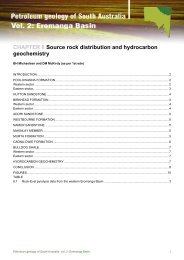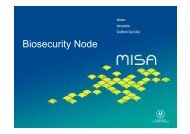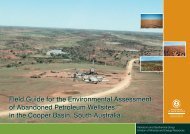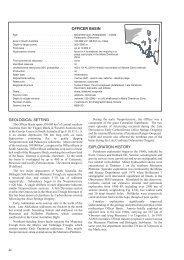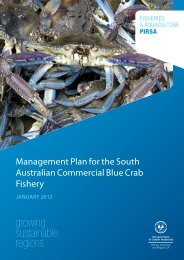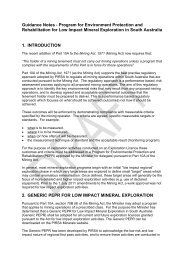Chapter 2: History of petroleum exploration and development - PIRSA
Chapter 2: History of petroleum exploration and development - PIRSA
Chapter 2: History of petroleum exploration and development - PIRSA
You also want an ePaper? Increase the reach of your titles
YUMPU automatically turns print PDFs into web optimized ePapers that Google loves.
Petroleum geology <strong>of</strong> South Australia. Vol. 4: Cooper Basin.We had looked very closely at the logs <strong>and</strong> the results <strong>of</strong>Gidgealpa 1, which had incidentally encountered abeautiful permeable section in the Permian. That Permiansection had been washed out so badly by sloppy drillingthat it was impossible to test most <strong>of</strong> it because youcouldn’t find an open hole test tool for it. It was equallyimpossible to set casing in cement because there wasn’t aperforating tool which would be able to perforate that thickcement jacket. Now knowing that, we suspected, again onthe logs, that some <strong>of</strong> the s<strong>and</strong>s could be prospective. Weknew from the seismic the s<strong>and</strong>s would thin across theGidgealpa structure but there was still good evidence that athin Permian s<strong>and</strong> cover would extend right across theanticline.We therefore suggested that they should drill a second holeor, knowing damn well that there wasn’t a tool in Australiawhich could do the job, test the Permian section inGidgealpa 1 to the Minister’s satisfaction. This we wereable to do under the Petroleum Act <strong>and</strong> we dem<strong>and</strong>ed thatthe companies fulfil the wish <strong>of</strong> the Government to test thePermian section in Gidgealpa 1 or alternatively drill asecond well on structure or near the structure culmination.Of course this started a really extensive controversybetween geophysicists, between geologists <strong>and</strong> betweenthe various companies. Santos <strong>and</strong> Total didn’t want tohave a bar <strong>of</strong> a second well. They didn’t want to test either,because they knew they couldn’t. Delhi was divided: theChief Geophysicist <strong>of</strong> Delhi, Frank Hinson, resigned fromDelhi because he was <strong>of</strong> the opinion that the structurewould be bald-headed. This was at a party given to thehonour <strong>of</strong> Norm Miller <strong>and</strong> some other high ranking peoplefrom Delhi’s US organisation, who again had came out tosettle some <strong>of</strong> the argument. It was at that party given byRalph Freeman (a Senior Geologist with Delhi) that Frankput down the law <strong>and</strong> told the Chief Geologist <strong>of</strong> Delhi inno uncertain terms what he could do with his job. It wasgreat fun.Finally it came to a meeting at the Department: theparticipants were Tom Barnes, Lee Parkin, John Klug fromSantos, who was then Operational Manager, Reg Sprigg,also acting on behalf <strong>of</strong> Santos, Jeff Greer from Delhi,Claude de Lapparent from Total <strong>and</strong> me. The Departmentmade it quite clear that we would not budge from ourposition: either one <strong>of</strong> the works would have to be carriedout. So they left. Delhi was inclined towards the secondwell. Then the whole thing actually went back to theMinister. It went to Tom Playford <strong>and</strong> it took TomPlayford’s well-known gentle persuasion <strong>and</strong> arm twistingwith some <strong>of</strong> the Directors <strong>of</strong> Santos that Santos wouldfinally agree that the second well would be drilled. Thatsecond well was Gidgealpa 2.Gidgealpa 2 capped by a ‘Christmas tree’ <strong>and</strong> ready for gasproduction. (Photo N013046)received more than £1.5 million in drilling <strong>and</strong> geophysicalsubsidies, which placed the partners fourth on the list <strong>of</strong>subsidy recipients from 1958–59 to 1963–64 (AustralasianOil <strong>and</strong> Gas Journal, 1965). Over time there were numerousrevisions <strong>and</strong> refinements to the scheme. Some such as theamendments in 1964 adversely affected <strong>exploration</strong> in theCooper Basin: they removed the subsidy for boreholesurveys <strong>and</strong> detailed structure drilling, reduced the subsidyrate for test drilling <strong>and</strong> stratigraphic drilling, <strong>and</strong> introducedexclusion circles. The latter, ‘one <strong>of</strong> the more controversialmodifications to the Acts’, were ‘defined areas arounddiscovery wells <strong>and</strong> fields which were excluded fromsubsidy’ (Passmore, 1994). The 64 km circle imposedaround Gidgealpa <strong>and</strong> Moomba included the mostsignificant discoveries in the basin to then. The originaldrilling at Gidgealpa had been subsidised under the scheme.Assessing the potential <strong>of</strong> the Gidgealpa Field <strong>and</strong>further <strong>exploration</strong> in the region occupied much <strong>of</strong> 1964.Four wells were drilled on the Merrimelia structure in 1964<strong>and</strong> 1965 <strong>and</strong> the first recorded sign <strong>of</strong> oil, apart from dullyellow fluorescence, in Triassic sediments was made inHeli Wopfner relating the flavour <strong>of</strong> the times (O’Neil, 1989a).Wopfner’s diaries, <strong>PIRSA</strong> (1963) <strong>and</strong> O’Neil (1989c, 1990)support Wopfner’s account that the department’s insistence onGidgealpa 2 being drilled led to the gas discovery.that the Petroleum Search Subsidy Act was one <strong>of</strong> the majorfactors which led to success in the search for <strong>petroleum</strong>, bothoil <strong>and</strong> gas, in this country. It was one <strong>of</strong> the features whichencouraged overseas capital into the search in Australia’(Rudd, 1966). Having induced overseas companies toAustralia, the industry came to rely on them for growth <strong>and</strong>support, especially as many <strong>of</strong> the local companies did nothave sufficient capital to qualify for subsidy payments or tosustain proper programs. Delhi–Santos, for example,Unable to conceal his delight at the optimistic <strong>development</strong>s atGidgealpa, Premier Playford displays a beer bottle containing thefirst distillate from Gidgealpa 2 while the General Manager <strong>of</strong>Santos, John Klug, looks on approvingly at Adelaide Airport, 16February 1964. (Courtesy <strong>of</strong> the Advertiser; photo 42772)23










